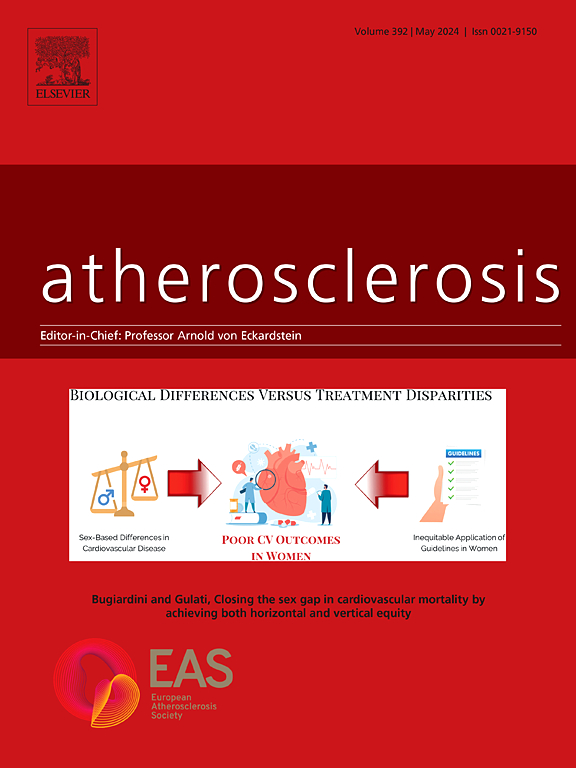高敏感性肌钙蛋白对动脉粥样硬化性血管疾病严重程度的预后价值
IF 4.9
2区 医学
Q1 CARDIAC & CARDIOVASCULAR SYSTEMS
引用次数: 0
摘要
背景和目的动脉粥样硬化性血管疾病(ASVD)患者影响两个或多个不同的血管床,被称为多血管疾病(PolyVD),其不良后果的风险增加。在这些患者中,高敏感性肌钙蛋白T和I (hsTnT/I)的预后效用尚待研究。因此,我们的目的是在当代队列中探讨hsTnT/I与ASVD程度和预后之间的关系。方法纳入在队列研究interath中接受冠状动脉造影且hsTnT/I浓度可用的患者。建立无ASVD、单血管疾病(MVD)和多血管疾病患者亚组。通过Cox回归分析来研究hsTnT/I与ASVD程度和临床结局(全因死亡率和主要不良心血管事件;梅斯)。结果2273例患者中,hsTnT和hsTnI随ASVD程度逐渐升高。然而,调整后,这种关联在统计学上不显著。hsTnT和hsTnI与PolyVD的全因死亡率独立相关(hsTnT每标准差校正风险比:1.42 [95% -CI: 1.16, 1.73];p & lt;0.001, hsTnI: 1.38 [1.14, 1.68];p = 0.0013)和MVD (hsTnT: 1.32 [1.15, 1.51];p & lt;0.001, hsTnI: 1.35 [1.17, 1.56];p & lt;0.001),而在ASVD负担中没有发现hsTn与MACE的关联。结论ASVD程度越高的患者hsTnT/I浓度越高,全因死亡率和MACE发生率也越高。hsTnT/I浓度与ASVD患者的全因死亡率可靠相关,强调了生物标志物在风险预测中的作用。本文章由计算机程序翻译,如有差异,请以英文原文为准。

Prognostic utility of high-sensitivity troponins according to atherosclerotic vascular disease severity
Background and aims
Patients with atherosclerotic vascular disease (ASVD) affecting two or more different vascular beds, so called Polyvascular disease (PolyVD), are at an increased risk for adverse outcomes. In those patients, the prognostic utility of high-sensitivity troponin T and I (hsTnT/I) is under-investigated. We therefore aimed to explore the association between hsTnT/I with the extent of ASVD and outcomes in a contemporary cohort.
Methods
Patients undergoing coronary angiography with available hsTnT/I concentrations from the cohort study INTERCATH were included. Subgroups of patients without ASVD, monovascular disease (MVD), and PolyVD were created. Cox regression analyses were computed to investigate the associations of hsTnT/I with the extent of ASVD and clinical outcomes (all-cause mortality and major adverse cardiovascular events; MACE).
Results
In 2273 included patients, a stepwise increase of both hsTnT and hsTnI was observed according to the extent of ASVD. However, this association was statistically not significant after adjustment. hsTnT and hsTnI were independently associated with all-cause mortality for PolyVD (adjusted hazard ratio per standard deviation for hsTnT: 1.42 [95 %-CI: 1.16, 1.73]; p < 0.001 and hsTnI: 1.38 [1.14, 1.68]; p = 0.0013) and MVD (hsTnT: 1.32 [1.15, 1.51]; p < 0.001 and hsTnI: 1.35 [1.17, 1.56]; p < 0.001), whereas no association of hsTn with MACE was seen across the burden of ASVD.
Conclusions
Patients with a greater extent of ASVD had higher concentrations of hsTnT/I and an increased incidence of all-cause mortality as well as MACE. hsTnT/I concentrations were reliably linked to all-cause mortality in patients with ASVD, underscoring the role of biomarkers in risk prediction.
求助全文
通过发布文献求助,成功后即可免费获取论文全文。
去求助
来源期刊

Atherosclerosis
医学-外周血管病
CiteScore
9.80
自引率
3.80%
发文量
1269
审稿时长
36 days
期刊介绍:
Atherosclerosis has an open access mirror journal Atherosclerosis: X, sharing the same aims and scope, editorial team, submission system and rigorous peer review.
Atherosclerosis brings together, from all sources, papers concerned with investigation on atherosclerosis, its risk factors and clinical manifestations. Atherosclerosis covers basic and translational, clinical and population research approaches to arterial and vascular biology and disease, as well as their risk factors including: disturbances of lipid and lipoprotein metabolism, diabetes and hypertension, thrombosis, and inflammation. The Editors are interested in original or review papers dealing with the pathogenesis, environmental, genetic and epigenetic basis, diagnosis or treatment of atherosclerosis and related diseases as well as their risk factors.
 求助内容:
求助内容: 应助结果提醒方式:
应助结果提醒方式:


